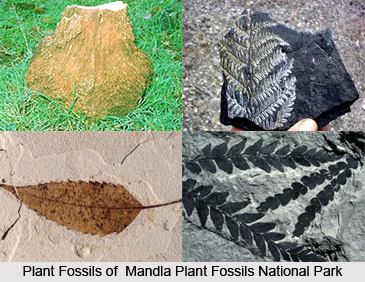 Mandla Plant Fossils National Park is well-known for its large collection of plant fossils which include palms, gymnosperms, angiosperms - monocotyledons, bryophytes and is situated in Dindori District, Madhya Pradesh. Such unique fossils are believed to have been existent in the country about 40 million to 150 million years ago, particularly present in villages of Mandla District which include Deori Kohani, Barbaspur, Charagaon, Umaria, Chanti-hills, Deorakhurd and Ghughua. The national park occupies an area measuring about 2, 74, 100 square metres. Intensive research has been conducted by the Birbal Sahni Institute of Palaeobotany, Lucknow on the various kinds of plant fossils of Mandla National Park, and the study is in its preliminary condition. The park occupies 5000 square metres.
Mandla Plant Fossils National Park is well-known for its large collection of plant fossils which include palms, gymnosperms, angiosperms - monocotyledons, bryophytes and is situated in Dindori District, Madhya Pradesh. Such unique fossils are believed to have been existent in the country about 40 million to 150 million years ago, particularly present in villages of Mandla District which include Deori Kohani, Barbaspur, Charagaon, Umaria, Chanti-hills, Deorakhurd and Ghughua. The national park occupies an area measuring about 2, 74, 100 square metres. Intensive research has been conducted by the Birbal Sahni Institute of Palaeobotany, Lucknow on the various kinds of plant fossils of Mandla National Park, and the study is in its preliminary condition. The park occupies 5000 square metres.
The fact whether the fossils belong to the early or mid Cretaceous Age, or the latter part of Jurassic Age is still clouded in mystery. Geologists have claimed that this occurred due to the shift of the subcontinent Pangaea into Gondwana and Laurasia, at certain point of time between the Cretaceous and Jurassic Ages. Many years ago, India represented a portion of Gondwana. Fossils of mollusks are also existent within the plant fossils and it is believed that the locale of the fossils, near Narmada Valley, Mandla, was previously a deep intrusion of the ocean into the peninsular part of India till the Post-Cambrian Age, which dates back to more than 40 million years ago. This suggests that Narmada River was quite short which lead to the sea located above Mandla District and certain geological issues were created by the recession of the sea. Scientists are of the view that this had resulted in the rift valley of Narmada and Tapi Rivers which flow into the Arabian Sea.
The ancient fossils of Mandla Plant Fossils National Park reflect the appearance of Madhya Pradesh over millions of years ago. This area lacked dicotyledons which prove that the evolution was yet at an immature stage. Mandla Plant Fossils National Park is stretched over vast tracts of agricultural fields within the boundaries of residential villages, which is the reason why it is quite a challenge to preserve the fossils. The old fossils resemble ordinary rocks and are often replaced from their original spots by agriculturists or destroyed by tourists. Many people make attempts to sell these unique rock-faces and earn quick money out of it. Excavations of embedded mollusks have led to extensive damage in Deorhi Kohani and Charagaon villages.
Visiting Information
To approach Mandla Plant Fossils National Park, one should avail the Shahpura national bus which would take the tourists to Mandla District. Fruit fossils, wood fossils and leaf impressions are an important part of the fossils in this national park.



















